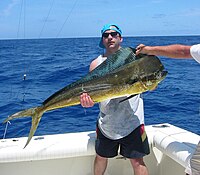|
Mahi (Dolphin) Fishing Miami
The Mahimahi (in Hawaiian), Coryphaena hippurus, also known as common dolphin-fish, Dorado maverikos, or lampuki (in Maltese) are surface-dwelling ray-finned fish found in off-shore tropical and subtropical waters worldwide. They are one of only two members of the Coryphaenidae family, the other being the Pompano dolphinfish. Called by the common name, dolphinfish, the mahi-mahi is a fish, and is unrelated to the Delphinidae family of mammals correctly referred to by the common name, dolphin. Although, while technically incorrect, it is also common to refer to the mahi-mahi simply as dolphin, rather than dolphinfish.
Confusion over the spelling of this name derives from the Hawaiian word, mahimahi, being adopted into the English language in a variety of forms. The American Heritage Dictionary, fourth edition, cites the preferred spelling (occurring “more frequently”) as the hyphenated mahi-mahi. The secondary spelling is the single word, mahimahi, with the identical Hawaiian word given as the derivational source. But the Random House Webster’s Unabridged, second edition, offers the reverse of this preference order, with the single word being preferred to the hyphenated version.
General characteristics
Mahi-mahi have a lifespan of 4 to 5 years. Catches average 7 to 13 kg (15 to 28 pounds). They seldom exceed 15 kg (33 pounds), and any mahi-mahi over 18 kg (39 pounds) is exceptional. Mahi-mahi have compressed bodies and long dorsal fins extending almost the entire length of their bodies. Their anal fins are sharply concave. They are distinguished by dazzling colors: golden on the sides, bright blues and greens on the sides and back. Males and female have similar shaped bodies except for their heads. Mature males have prominent foreheads protruding well above the body proper. Females have a rounded head. Females are also usually smaller than males.
When they are removed from the water, the fish often change color among several hues (this being the reason for their Spanish name, Dorado Maverikos), finally fading to a muted yellow-grey upon death.
Mahi-mahi are among the fastest-growing fish. They are fast swimmers as well, with a top swimming speed of 50 knots. Mahi-mahi spawn in warm ocean currents throughout much of the year, and its young are commonly found in sargassum weed.
Mahi-mahi are carnivorous, feeding on flying fish, crabs, squid, mackerel, and other small fish. They have also been known to eat zooplankton and crustaceans. As food, mahi-mahi have a chicken-like taste and texture. But some restaurants will substitute a soft flaky white fish instead of real mahi mahi because it is cheaper.


Mahimahi caught in Mauritius


Bull (male) Mahimahi caught in the Florida Keys
Image:Female shark Fish.JPG
Female Mahimahi caught off the coast of Jamaica
Mahimahi are highly sought for game fishing and commercial purposes. Game fishery is popular due to their beauty. Mahimahi have become popular as a dish in many restaurants.
Location
Mahi-mahi can be found in the Caribbean Sea, on the west coast of North and South America, the Gulf of Mexico, Southeast Asia and many other places worldwide. The United States and the Caribbean countries are the primary consumers of mahi-mahi products, but many European countries are increasing their consumption every year.
Japan is a strong consumer as well. Hawaii has both a mahi-mahi fishery and is a consumer.
The Arabian Sea is also a great place to catch mahi-mahi, particularly the coast of Oman. At first, most mahi-mahi were a by-catch (incidental catch) in the tuna/swordfish longline fishery. Now they are sought after by commercial fishermen off the Pacific Coast of Latin America, from Peru to Costa Rica. Recreational anglers also catch mahi-mahi offshore in the Atlantic Ocean from New Jersey to Florida.
Florida Keys mahi-mahi fishing is a very popular sport. Dolphinfish are among the most sought-after offshore fish during summer, and they can be found throughout the Florida Keys. They are a fast-growing species so it would be hard to deplete the fisheries. Fresh mahi-mahi is served in many restaurants in the Florida Keys and Key West.
Fishing charters most likely go out to the edge of the reef in about 120 feet of water and begin looking for floating debris and frigate birds. Dolphin tend to hang out around debris such as floating boards, palm trees and fronds, or Sargasso weed lines.
Sargasso is floating grass that sometimes holds a complete eco-system from microscopic creatures to seahorses and baitfish. The frigate birds dive for food accompanying the debris or Sargasso. Other fish may be present in the area. Experienced fishing guides can tell what species are likely around the debris by the birds' behavior.
Thirty- to 50-pound gear is more than adequate for trolling for dolphin. Fly-casters may especially seek frigate birds to find big dolphin and then use a bait-and-switch technique. Ballyhoo or a net full of live pilchards tossed into the water can excite the dolphin into a feeding frenzy. Hookless teaser lures can also be employed in the same manner. After tossing the teasers or live chum, throw the fly to the feeding dolphin. Once on a line, dolphin are fast, flashy and acrobatic, with beautiful blue, yellow, green and even red dots of color.
Environmental and Food Safety Concerns
The Monterey Bay Aquarium classifies the fish, when caught in the US, as a "Good Alternative", the middle of its three categories of their environmental impact to the ocean. The Aquarium advises to "Avoid" imported mahimahi.
The Natural Resources Defense Council (NRDC) classifies mahimahi as a "moderate mercury" fish or shellfish (its second lowest of four categories), and suggests eating six servings or less per month.[1]
The Environmental Defense Fund (EDF) classifies mahimahi caught by line/pole in the US as "Eco-Best" in its three-category system [2], but classifies all mahimahi caught by longline as only "Eco-OK" or "Eco-Worst" due to longline "high levels [of] bycatch, injuring or killing seabirds, sea turtles and sharks."
South Florida and Miami fishing available at an affordable price. |











